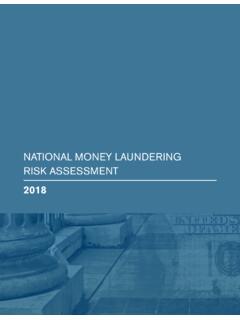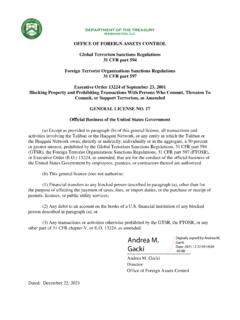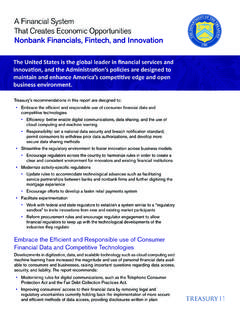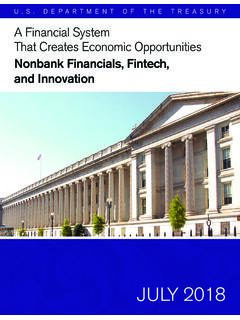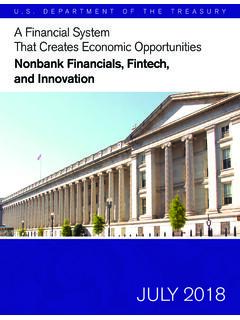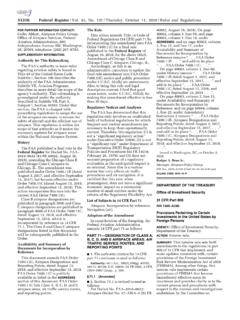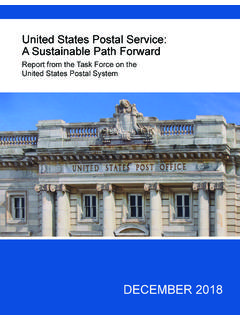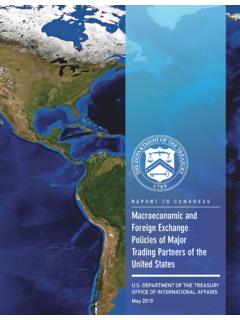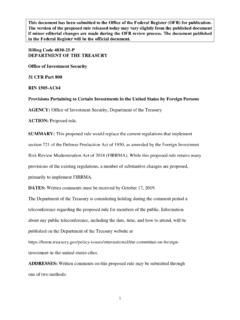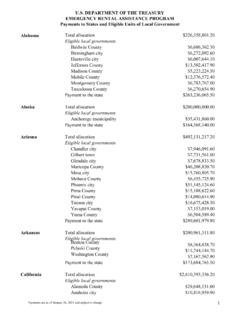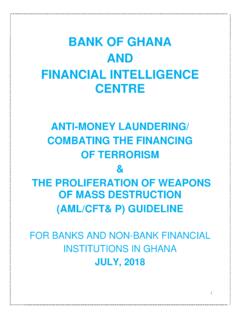Transcription of Study of the Facilitation of Money Laundering and Terror ...
1 Study of the Facilitation of Money Laundering and Terror Finance Through the Trade in Works of Art February 2022. Department of the Treasury Study of the Facilitation of Money Laundering and Terror Finance Through the Trade in Works of Art Table of Contents I. 2. II. Definitions and 6. i. Aims and ii. Art Definition and iii. III. How is Art Sold?.. 9. i. Primary vs. Secondary ii. The Art IV. Art Market Participants and Their i. Auction ii. iii. Art iv. Online v. Museums, Universities, and Other vi. Third-Party vii. Art viii. ix. Free-Trade Zones and Art Storage V. Mechanisms to Launder Money Through i. Use of High-Value Art as a Conduit for Money ii. Examples of Money Laundering Through the High-Value Art a. Art as a Medium of Exchange or Value b. Art Used to Hide Illicit c. Art Used as Collateral to Obscure Illicit VI. Emerging Digital Art VII.
2 Terrorist Financing and Art: Market VIII. Utility in Tax IX. Complicit X. Potential Regulatory Considerations and Other Study of the Facilitation of Money Laundering and Terror Finance Through the Trade in Works of Art i Executive Summary Section 6110(c) of the Anti- Money Laundering Act of 2020, enacted as part of the William M. (Mac) Thornberry National Defense Authorization Act for Fiscal Year 2021, directs the Department of the Treasury to Study the Facilitation of Money Laundering (ML) and Terror finance (TF) through the trade in works of art (the Study ). This Study identifies art market participants and sectors of the high-value art market in the United States that may present ML and TF risks to the financial system. The Study also examines what efforts government agencies , regulators, and market participants should explore to further mitigate these risks.
3 Most art market participants, including some entities that provide financial services within the high-value art market, are not subject to anti- Money Laundering /countering the financing of terrorism (AML/CFT). obligations. Several qualities inherent to art, the high-value art market, and market participants may make the market attractive for ML by illicit actors. Specifically, the high-dollar values of single transactions, the ease of transportability of works of art, the long-standing culture of privacy in the market (including private sales and transactions), and the increasing use of art as an investment or financial asset, all could make trade in high-value art vulnerable to ML. However, the infrequent use of cash in the high-value art market and preexisting requirements for financial institutions and commercial businesses to report high-value cash transactions, both of which are described later in this Study , may make the institutional high-value art market a poor vehicle for Laundering illicit cash proceeds.
4 The Study found some evidence of ML risk in the institutional high-value art market but found little evidence of TF risk. Furthermore, the emerging online art market may present new risks, depending on the structure and incentives of certain activity in this sector of the market ( , the purchase of non-fungible tokens [NFTs], digital units on an underlying blockchain that can represent ownership of a digital work of art). To mitigate these risks, some institutional art market participants, such as certain auction houses and galleries, maintain procedures for conducting due diligence on potential buyers and sellers. Institutional art market participants have inherent economic incentives, such as credit risk issues and reputation maintenance, to collect this information. These good business practices can collect information that may help reduce ML in the art market.
5 However, these programs are purely voluntary, and the procedures can be suspended or disregarded at the institution's discretion without the risk of the government (USG). bringing a civil or criminal enforcement action, which presents a vulnerability to the financial system. These programs are less common in certain areas of the online art market, such as with exchanges that host digital art transactions. Furthermore, illicit actors may attempt to utilize or bribe merchants, professionals, and financial services employees in the art market to ignore policies and best practices for a desired transaction. A significant portion of ML in the high-value art market is likely conducted with the help of such complicit professionals. While the use of complicit professionals is not unique to the art market it can happen in any profession or service the historically private nature of the high-value art market makes it more challenging for government authorities to identify and investigate potential ML.
6 To address these ML risks, the Study considers several regulatory and nonregulatory actions the USG should consider. Nonregulatory options include (1) providing government support for the creation and enhancement of private sector information-sharing programs to encourage transparency among art market participants and (2) updating guidance and training for law enforcement, customs enforcement, and asset recovery agencies . Regulatory options include (1) using targeted recordkeeping and reporting requirements to support information collection and ML activity analyses and (2) applying comprehensive AML/CFT measures to certain art market participants. Weighed against other sectors that pose ML/TF risks, the Study concludes that the art market should not be an immediate focus for the imposition of comprehensive AML/CFT requirements. Study of the Facilitation of Money Laundering and Terror Finance Through the Trade in Works of Art 1.
7 Study of the Facilitation of Money Laundering and Terror Finance Through the Trade in Works of Art On January 1, 2021, the Congress enacted the Anti- Money Laundering Act of 2020 (the AML Act) as part of the William M. (Mac) Thornberry National Defense Authorization Act for Fiscal Year 2021 (NDAA).1. Section 6110 of the AML Act includes several AML/CFT provisions related to antiquities and art. Section 6110(c) of the AML Act directs the Department of the Treasury (Treasury) to conduct a Study of the Facilitation of ML and TF through the trade in works of art, including an analysis of the following: 1. The extent to which the Facilitation of ML and TF through the trade in works of art may enter or affect the financial system of the United States, including any qualitative or quantitative data or statistics;. 2. An evaluation of which markets, by size, entity type, domestic or international geographical locations, or otherwise, should be subject to any regulations.
8 3. The degree to which the regulations, if any, should focus on high-value trade in works of art and on the need to identify the actual purchasers of such works, in addition to the agents or intermediaries acting for or on behalf of such purchasers;. 4. The need, if any, to identify persons who are dealers, advisors, consultants, or any other persons who engage as a business in the trade in works of art;. 5. Whether thresholds and definitions should apply in determining which entities, if any, to regulate;. 6. An evaluation of whether certain exemptions should apply;. 7. Whether information on certain transactions in the trade in works of art has a high degree of usefulness in criminal, tax, or regulatory matters; and 8. Any other matter the Secretary of the Treasury determines is appropriate. I. Introduction The global trade in art is a multi-billion-dollar industry.
9 According to The Art Market 2021, a leading industry report published by UBS and Art Basel,2 in 2020, global sales of art were valued at an estimated $50 billion, down from approximately $67 billion worldwide just a few years This decrease is likely primarily due to the ongoing COVID-19 pandemic. According to the same Study , the United States, the United Kingdom, and China account for an estimated 82 percent of global art sales by value, with the share estimated at 42 percent ($ billion).4 Headlines consistently identify paintings sold by galleries or at auctions that are valued in the hundreds of millions of In 2017, Christie's auction house sold a painting for nearly half a billion dollars, the most expensive sale on High-value art has even been purchased by investors speculating with excess capital to 1. Pub. L. No. 116-283. 2. UBS is a Swiss financial institution, and Art Basel is a well-known art fair organizer.
10 Both entity types and their relation to the wider art market are described later in the Study . 3. Clare McAndrew, The Art Market 2021, Art Basel and UBS, 2021, available at 4. Id. 5. See, for example, Robert Frank, Blockbuster art week sets record with more than $ billion in sales, CNBC, November 23, 2021, available at 6. Kelly Crow, Leonardo da Vinci Painting Salvator Mundi' Smashes Records With $ Million Sale, Wall Street Journal, November 16, 2017, available at 2 Study of the Facilitation of Money Laundering and Terror Finance Through the Trade in Works of Art allocate,7 demonstrating the viability of art as an investment asset class. Economic growth, rising purchasing power, and growing disposable income in the global economy are also likely driving factors behind the thriving high-value art market. Technological innovations, such as the rise of distributed ledger technology and NFTs, have presented and continue to present new opportunities for the exploration of creative media, and financial innovations in cross-border payments have allowed the global art market to thrive and expand.
